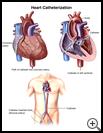
Heart Catheterization
________________________________________________________________________
KEY POINTS
- Heart catheterization is a test that uses X-rays with contrast dye to look at your child’s heart in detail.
- Ask your child’s provider how long it will take to recover and how to take care of your child at home.
- Make sure you know what symptoms or problems you should watch for and what to do if your child has them.
________________________________________________________________________
What is heart catheterization?
Heart catheterization is a test that uses contrast dye that shows up on X-rays to look at your child’s heart in detail. This test is also called cardiac catheterization.
When is it used?
Heart catheterization helps your child’s healthcare provider diagnose and treat heart problems. A child born with a heart problem may need to have catheterization to diagnose a defect and help your child’s healthcare provider decide on treatment.
Heart catheterization may be used to:
- Look for signs that show the health of your child’s heart and lungs such as:
- Measure the blood pressure in the blood vessels in your child’s lungs and heart and in the chambers of your child’s heart.
- Check how well your child’s heart valves open and close.
- Measure blood flow and the amount of oxygen in your child’s blood in different parts of your child’s heart.
- Measure how well your child’s heart is pumping blood to the body.
- Take a tissue sample (biopsy) of the heart muscle using a tool passed through the catheter.
- Correct heart problems that cause a child to have gray or bluish color to skin.
- Place mesh devices that close small holes inside the heart.
- Correct blood flow in a blood vessel.
- Place devices called stents in narrowed arteries to keep them open.
How do I prepare my child for this procedure?
- Your child may or may not need to take regular medicines the day of the procedure. Tell the healthcare provider about all medicines and supplements your child takes. Some products may increase the risk of side effects. Ask the healthcare provider if your child needs to avoid taking any medicine or supplements before the procedure.
- Tell the healthcare provider if your child has any food, medicine, or other allergies such as latex.
- Your child’s provider will tell you when your child needs to stop eating and drinking before the procedure. This helps to keep your child from vomiting during the procedure.
- Follow any other instructions your child’s healthcare provider may give you.
- Ask any questions you have before the procedure. You should understand what your child’s provider is going to do. You have the right to make decisions about your child’s healthcare and to give permission for any tests or procedures.
What happens during the procedure?
This test is done at the hospital or day surgery center.
Your child will be given medicines that help relax, but your child may stay awake during the test if your child is older. Your child will be given a local anesthetic to numb the area where the catheter will be inserted. Your child may also be given medicine to help prevent blood clots.
Your child’s healthcare provider will put a small tube called a catheter through your child’s skin and into a blood vessel in the groin, arm, or neck. Tools may be passed through the catheter to take measurements or do other planned procedures such as a biopsy. Contrast dye may be put into the artery, and your child may feel a warm or hot flush spreading over the body for a few seconds when the contrast dye is given. X-rays will be taken as the contrast dye moves through your child’s blood vessels. The X-rays will show if there is a blockage, narrowing, or deformity of the blood vessels in your child’s heart.
At the end of the test, your child’s healthcare provider will remove the catheter and put pressure on the area where the catheter was inserted (the puncture site) to control any bleeding.
The test usually takes about an hour.
What happens after the procedure?
After the procedure your child may stay in a recovery area for at least a few hours or overnight, depending on what was done during the procedure. The puncture site may be bruised and sore for a few days.
Ask your child’s healthcare provider:
- How and when you will get your child’s test results
- How long it will take to recover
- If there are activities your child should avoid and when your child can return to normal activities
- How to take care of your child at home
- What symptoms or problems you should watch for and what to do if your child has them
Make sure you know when your child should come back for a checkup. Keep all appointments for provider visits or tests.
What are the risks of this procedure?
Every procedure or treatment has risks. Some possible risks of this procedure include:
- Your child may have problems with anesthesia.
- Your child may have an infection, bleeding, or blood clots. Other parts of your child’s body may be injured during the procedure.
- Rarely, your child may have an allergic reaction to the contrast dye.
- The test can cause irregular heart rhythms, which might need treatment.
Ask your child’s healthcare provider how these risks apply to your child. Be sure to discuss any other questions or concerns that you may have.
Last modified: 2022-01-03
Last reviewed: 2020-01-21

